You're using an outdated browser. Please upgrade to a modern browser for the best experience.

Submitted Successfully!
Thank you for your contribution! You can also upload a video entry or images related to this topic.
For video creation, please contact our Academic Video Service.
| Version | Summary | Created by | Modification | Content Size | Created at | Operation |
|---|---|---|---|---|---|---|
| 1 | Biswajit Panda | + 2567 word(s) | 2567 | 2021-12-20 09:10:08 | | | |
| 2 | Vicky Zhou | -4 word(s) | 2563 | 2021-12-21 01:40:48 | | |
Video Upload Options
We provide professional Academic Video Service to translate complex research into visually appealing presentations. Would you like to try it?
Cite
If you have any further questions, please contact Encyclopedia Editorial Office.
Panda, B. DMF as CO Surrogate in Carbonylation Reactions. Encyclopedia. Available online: https://encyclopedia.pub/entry/17340 (accessed on 13 December 2025).
Panda B. DMF as CO Surrogate in Carbonylation Reactions. Encyclopedia. Available at: https://encyclopedia.pub/entry/17340. Accessed December 13, 2025.
Panda, Biswajit. "DMF as CO Surrogate in Carbonylation Reactions" Encyclopedia, https://encyclopedia.pub/entry/17340 (accessed December 13, 2025).
Panda, B. (2021, December 20). DMF as CO Surrogate in Carbonylation Reactions. In Encyclopedia. https://encyclopedia.pub/entry/17340
Panda, Biswajit. "DMF as CO Surrogate in Carbonylation Reactions." Encyclopedia. Web. 20 December, 2021.
Copy Citation
Transition metal-catalyzed carbonylation reactions have emerged as one of the most relevant synthetic approaches for the preparation of carbonyl-containing molecules. The most commonly used protocol for the insertion of a carbonyl moiety is the use of carbon monoxide (CO) but, due to its toxic and explosive nature, this process is not suitable at an industrial scale. The chemistry of CO surrogates has received large attention as a way to use less expensive and more environmentally friendly methods. Among the various CO surrogates, N,N-dimethylformamide (DMF) has been paid greater attention due to its low cost and easy availability.
carbonylation
catalytic processes
CO surrogates
DMF
heterocycles
synthetic methods
1. Introduction
The carbonyl functional group is very common in both natural and synthetic organic compounds: on the one hand, its chemical reactivity often plays a crucial role in several biological processes [1]; on the other, its ability as a hydrogen-bonding acceptor allows for appealing applications in supramolecular chemistry [2][3]. In light of these considerations, the development of efficient synthetic methods for the preparation of carbonyl-containing compounds has long attracted the attention of organic chemists all over the world.
One of the most common approach for introducing carbonyl moieties is represented by transition metal-catalyzed carbonylation, i.e., reactions involving carbon monoxide (CO) as a source of the carbonyl group. From the first pioneering study on Pd-catalyzed carbonylation reactions, reported by Heck et al. in 1974 [4], several transition metal species (in particular palladium, rhodium, iridium, nickel, ruthenium, iron and cobalt) have been successfully applied as catalysts in the synthesis of countless carbonyl-functionalized molecules by carbonylation reactions involving CO as a C1-carbon source [5][6].
Although some examples of carbonylative protocols have even been applied on industrial scale (e.g., in the industrial synthesis of acetic acid by rhodium-catalyzed [7] or iridium-catalyzed [8] carbonylation of MeOH), one of the major drawbacks of these reactions is the difficulty in the handling, storage and transport of carbon monoxide, a flammable and toxic greenhouse gas. Therefore, the development of transition metal-catalyzed carbonylation protocols involving the use of CO surrogates, rather than CO gas, is a crucial aspect to address this challenge in the context of a more sustainable chemistry.
The CO surrogates are species able of producing in-situ carbon monoxide, as a result of suitable chemical reactions; in this way, toxic CO is generated and directly consumed in a closed reaction flask, thus avoiding the requirement of high-pressure equipment and minimizing its exposure to operators [9][10][11]. Thanks to these advantages, the application of CO surrogates in carbonylation reactions has known significant advances in the last years, becoming an attractive area of research for synthetic organic chemists. The most common CO surrogates are metal carbonyl complexes [12], formic acid [13], formates [14] and formaldehyde [15], although studies involving the use of oxalic acid [16], carbon dioxide [17], chloroform [18] and so on have been also reported.
In this context, N,N-dimethylformamide (DMF) has recently found space as an appealing CO surrogate in transition metal-catalyzed carbonylation reactions. Compared with other CO surrogates—such as metal carbonyl complexes, whose use in stoichiometric amounts is problematic on a large scale as it may cause serious environmental pollution, or formaldehyde, whose manipulation is far from trivial—DMF is a cheap and easily accessible compound, typically used as a polar aprotic solvent in several organic reactions, easy to manipulate and also compatible for scale-up (Scheme 1a).
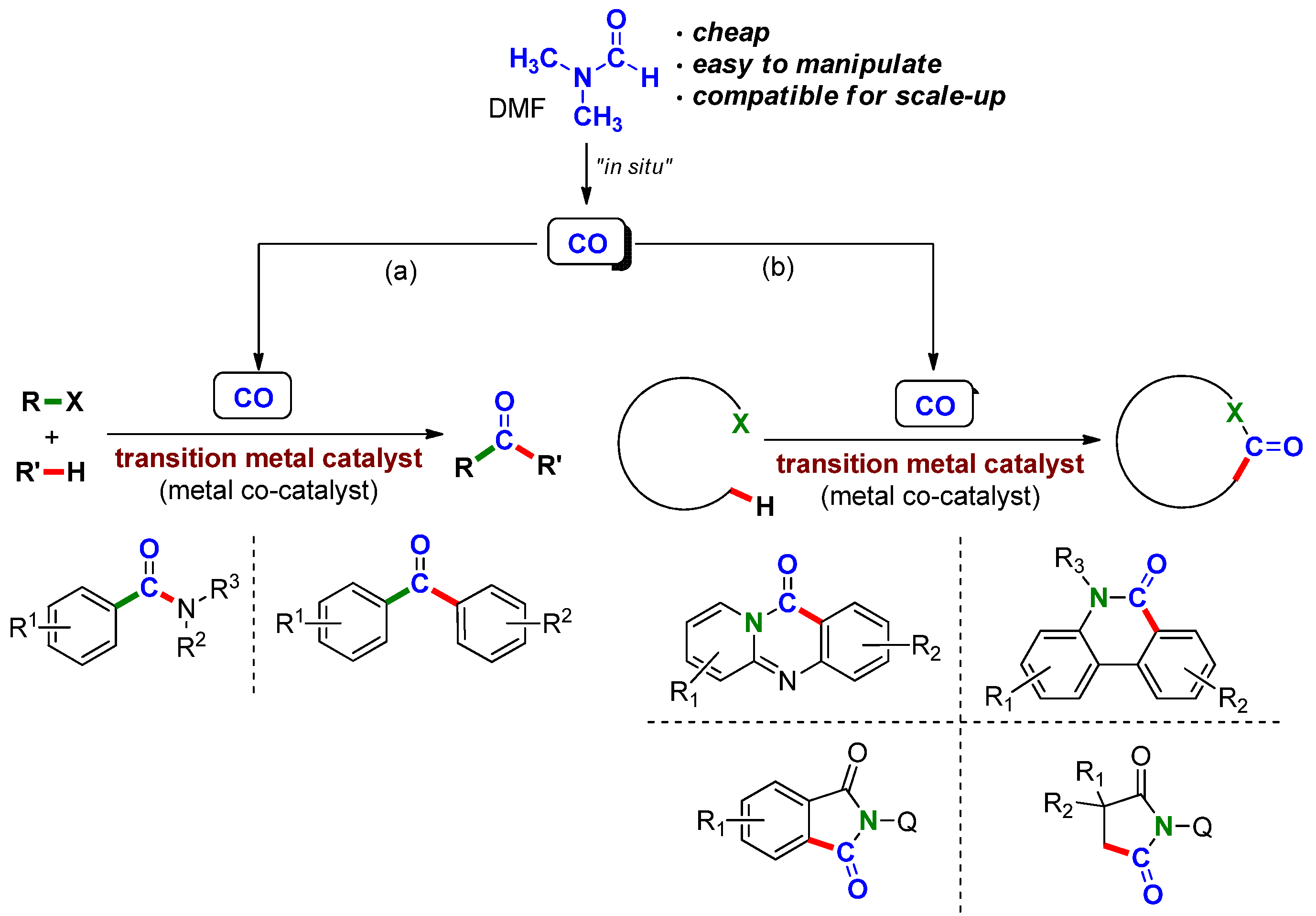
Scheme 1. Transition metal-catalyzed carbonylation reactions involving DMF as CO surrogate: (a) general scheme for the synthesis of carbonyl-containing molecules; (b) application to the synthesis of heterocycles.
Transition metal-catalyzed carbonylation reactions have acquired a prominent role in the field of the organic chemistry also for the synthesis of a multitude of useful carbonyl-containing heterocycles; in this context, we recently reported the application of cyclocarbonylative Sonogashira [19][20][21][22] and silylcarbocyclization reactions [23][24][25] for the synthesis of several classes of oxygen- and nitrogen-containing heterocycles. However, despite many advancements have been made in order to improve the feasibility and sustainability of these processes, the use of carbon monoxide represents a vexing problem which limits the widespread use of cyclocarbonylative reactions to some degree. The application of CO surrogates allowed to overcome this problem: in the last ten years, various carbonylative synthesis of heterocycles involving diverse CO surrogates have been successfully developed [26]. Thanks to the above-mentioned advantages, it should not be surprising that DMF is recently also finding success for the synthesis of heterocycles (Scheme 1b).
The application of DMF as a CO surrogate in metal-catalyzed carbonylation reactions has been partially described, to date, only as part of more general reviews, focusing on the use of DMF as a multipurpose building block in several classes of reactions [27] in carbonylation protocols involving diverse CO surrogates [6] or in the carbonylative synthesis of heterocycles based on several classes of CO surrogates [26]. However, in all these reports we found a pure description of the experimental conditions without any critical discussion of both advantages and disadvantages. Therefore, a complete overview only focused on transition metal-catalyzed carbonylations involving DMF as a CO surrogate, giving not only a general state of the art of these reactions for the preparation of carbonyl-containing molecules but also an in-depth discussion of their application in the synthesis of heterocycles, is still missing.
2. Synthesis of Heterocycles by Transition Metal-Catalyzed Carbonylation Reactions Involving DMF as a CO Surrogate
2.1. Synthesis of Heterocycles by Palladium-Catalyzed Carbonylation Involving DMF as a CO Surrogate
Most of the carbonylative protocols involving DMF as a CO surrogate were carried out in the presence of a palladium catalyst. Although the aforementioned studies were only applied to the synthesis of acyclic compounds, they well showed the central role played by palladium species in promoting these processes. Therefore, it should not be surprising that most of the synthesis of heterocycles by cyclocarbonylative reactions involving DMF as a CO surrogate reported to date are based on palladium catalysts.
The first study was described in 2015 by Wu and co-workers [28]: a palladium-catalyzed carbonylative cyclization of N-arylpyridin-2-amines 37 by C−H activation/annulation using DMF as a CO surrogate, affording quinazolinones 38 as the final products, which are typical structural motif in many pharmaceuticals and agrochemicals. Under optimized conditions, reactions were carried out by using Pd(OAc)2 (5–10 mol%) as the catalytic system under ligandless conditions, potassium persulfate (2–3 equiv.) as the oxidant, DMF acting as both reagent and solvent and trifluoroacetic acid as the co-solvent, at 140 °C under an O2 atmosphere (Scheme 2). Interestingly, some formamide analogues of DMF were also tested as an alternative source of CO, but only low yields of the resulting quinazolinones products were obtained. Concerning the substrate scope, N-arylpyridin-2-amines 37 bearing several functional groups on the benzene ring have been tested. Electron-donating substituents (i.e., methyl, phenyl, benzyloxy, dimethylamino and methylthio), as well as electron-withdrawing groups (like trifluoromethoxy and acetyl) were well tolerated, and the corresponding products were obtained in good to excellent yields. More interestingly, substrates bearing in the para, meta and/or ortho positions one or more halogen atoms, which are typically reactive in many palladium-catalyzed reactions, including the above described carbonylation reactions involving the use of DMF as a CO surrogate, were also compatible with the developed experimental conditions, affording the related quinazolinones products 38 in good yields.
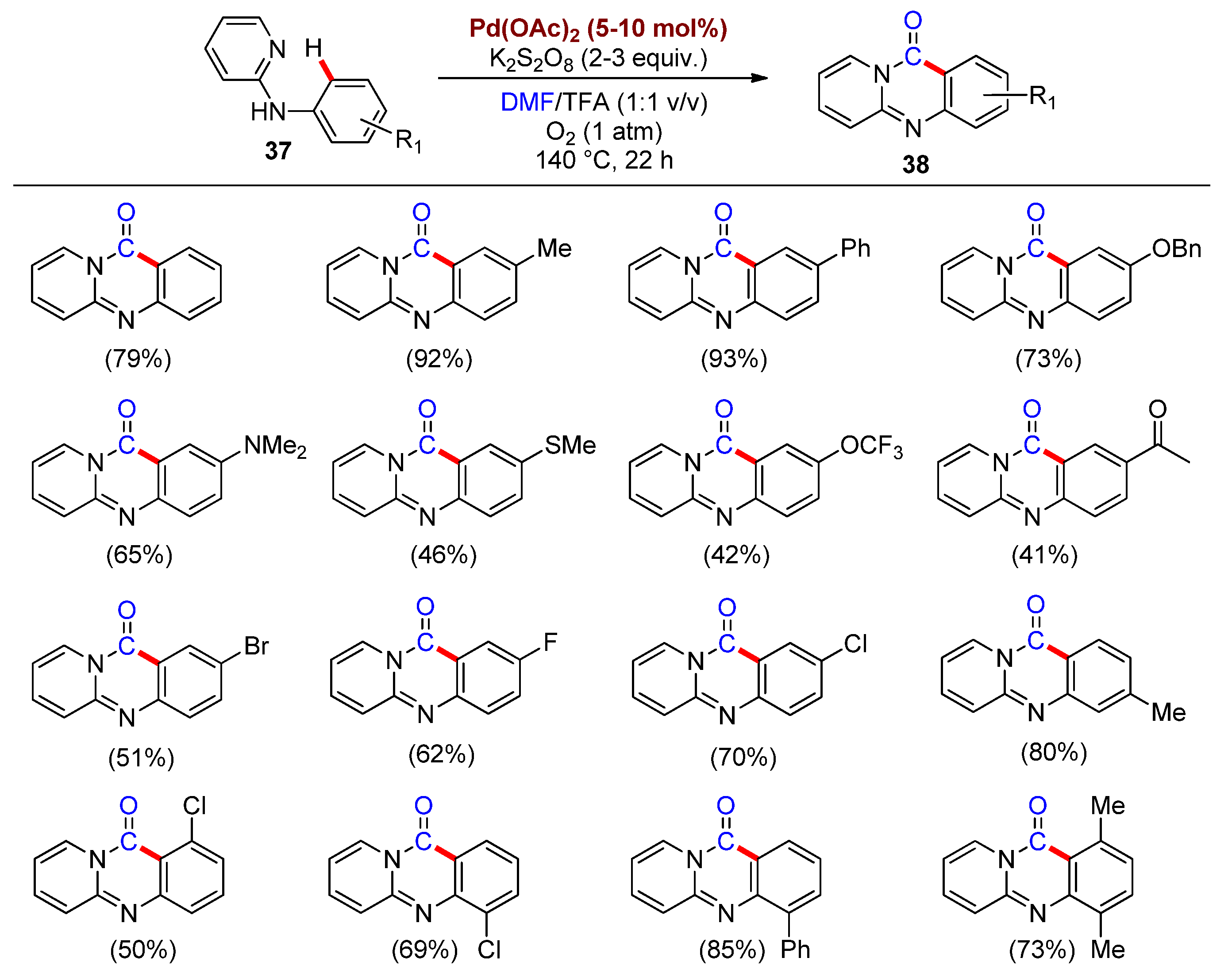
Scheme 2. Pd-catalyzed carbonylative cyclization of N-arylpyridin-2-amines 37 using DMF as a CO surrogate for the synthesis of quinazolinones 38, reported in 2015 by Wu and co-workers [28]. For each heterocyclic carbonylated product, the yield after chromatographic purification is reported in brackets.
The reaction mechanism proposed by the authors (Scheme 3) clearly highlights the role played by the Pd(OAc)2 catalyst. First of all, the coordination of the palladium(II) species to the substrate molecule 37 followed by the C−H activation step on the ortho position of the benzene ring afforded the Pd(II) complex 39. The combined effect of high temperatures and trifluoroacetic acid allowed for the decomposition of DMF and subsequent in-situ release of CO, which was then coordinated to complex 39, giving the metal carbonyl intermediate 40. The insertion of carbon monoxide into the Pd−C bond gave the acylpalladium(II) complex 41, followed by the reductive elimination step which afforded the final heterocyclic product 38 and a palladium(0) species. The occurrence of both K2S2O8 and O2 as oxidants was mandatory to close the catalytic cycle, since they allowed for the re-oxidation of Pd(0) to the starting Pd(II) catalyst. In order to confirm that DMF was the effective source of CO, the authors also performed some tests of carbonylative cyclization using a 13CO-labeled DMF.
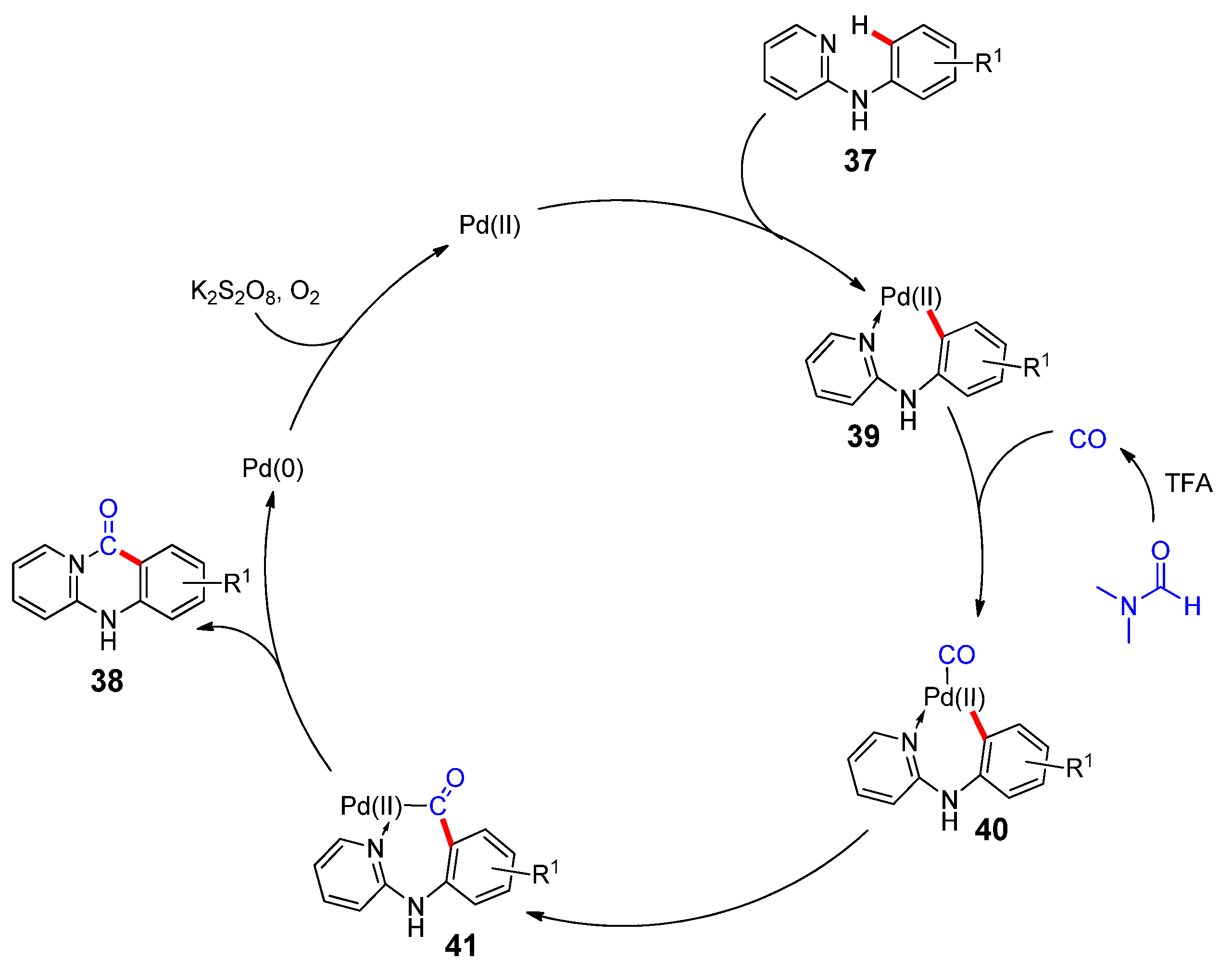
Scheme 3. Proposed reaction mechanism for the synthesis of quinazolinones 38 by Pd-catalyzed carbonylative cyclization of N-arylpyridin-2-amines 37 using DMF as a CO surrogate, reported in 2015 by Wu and co-workers [28].
2.2. Synthesis of Heterocycles by Nickel-Catalyzed Carbonylation Involving DMF as a CO Surrogate
Some examples of carbonylative protocols involving DMF as a CO surrogate were also carried out in the presence of a nickel catalyst, which is often used as a low-cost alternative to palladium catalysts in the context of carbon–carbon bond formation reactions. Although these studies were only applied to the synthesis of carbonyl-containing acyclic compounds, they clearly indicated the possibility of some applications of nickel species as efficient catalysts in the context of metal-catalyzed carbonylative cyclization involving DMF as a CO surrogate.
In 2015, Ge and co-workers reported the carbonylative cyclization of aromatic C(sp2)−H and aliphatic C(sp3)−H bonds of amides 55–57 using DMF as a CO surrogate, promoted by the synergistic action of Ni as the main catalyst and Cu as co-catalyst, to give phthalimides 56 and succinimides 58 as the final products [29]. Concerning the cyclocarbonylation of aromatic amides 55, reactions were carried out with NiI2 (10 mol%) as the main catalyst, Cu(acac)2 (20 mol%) as co-catalyst, Li2CO3 (0.4 equiv.) as a base, tetraheptylammonium bromide (THAB, 1.0 equiv.) as an additive, in DMF as both reagent and solvent under an O2 atmosphere (1 atm), at 160 °C for 24 h (Scheme 4). Under these conditions, benzamides bearing different functional groups were successfully treated to give the corresponding phthalimide products 56: in particular, substrates with electron-donating substituents (4-MeO, 4-Me, 3-MeO, 2-Me) afforded the corresponding products in higher yields compared to those bearing electron-withdrawing substituents (4-F, 4-Cl, 4-Br, 4-CN, 4-CF3, 4-NO2, 3-Br). Interestingly, reactions took place also with α- and β-naphthamides, affording the corresponding tricyclic imides in excellent yields, while no reactions occurred with heteroaromatic amides. Carbonylative cyclization of aliphatic amides 57 were instead carried out with NiBr2 (10 mol%) as the main catalyst, Cu(acac)2 (20 mol%) as the co-catalyst, Na2CO3 (0.3 equiv.) as base, tetrabutylammonium hexafluorophosphate (TBAPF6, 1.5 equiv.) as additive, in DMF acting as both reagent and solvent, under O2 atmosphere (1 atm), at 160 °C for 24 h (Scheme 5). Working with these optimized experimental conditions, 2,2-disubstituted propanamides bearing either linear or cyclic chains were successfully converted into the corresponding succinimides 58 in good-to-excellent yields: these results indicated a high site-selectivity in functionalizing the β-C(sp3)−H bond of the methyl group, rather than γ- or δ-C(sp3)−H bonds, showing that the formation of a five-membered ring is favored over the six- or seven-membered rings.
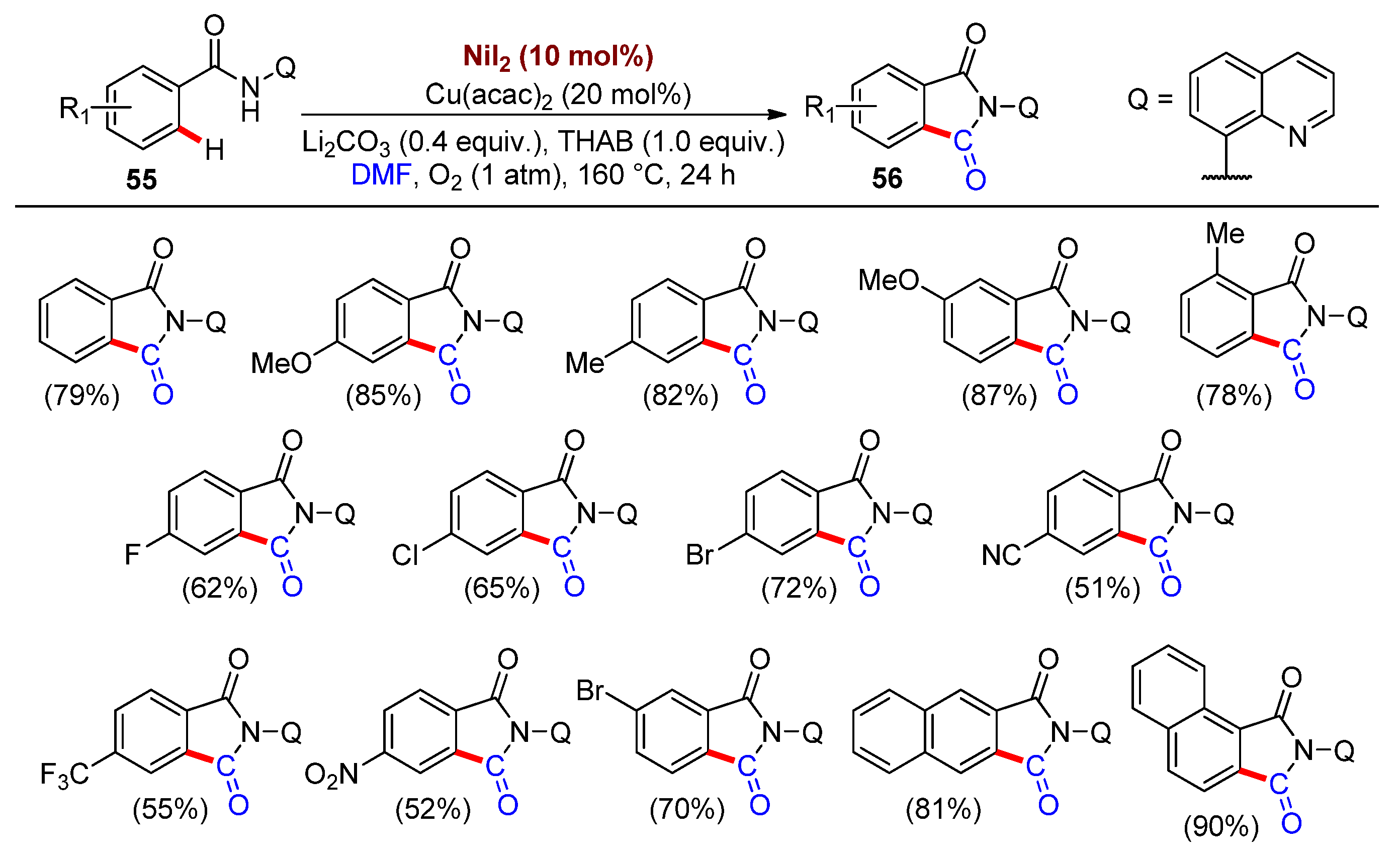
Scheme 4. Synthesis of phthalimides 56 by carbonylative cyclization of aromatic C(sp2)−H of amides 55 using DMF as CO surrogate, promoted by the synergistic action of NiI2 as the main catalyst and Cu(acac)2 as co-catalyst, reported in 2015 by Ge and co-workers [29]. For each heterocyclic carbonylated product, yield after column chromatography purification is reported in brackets.
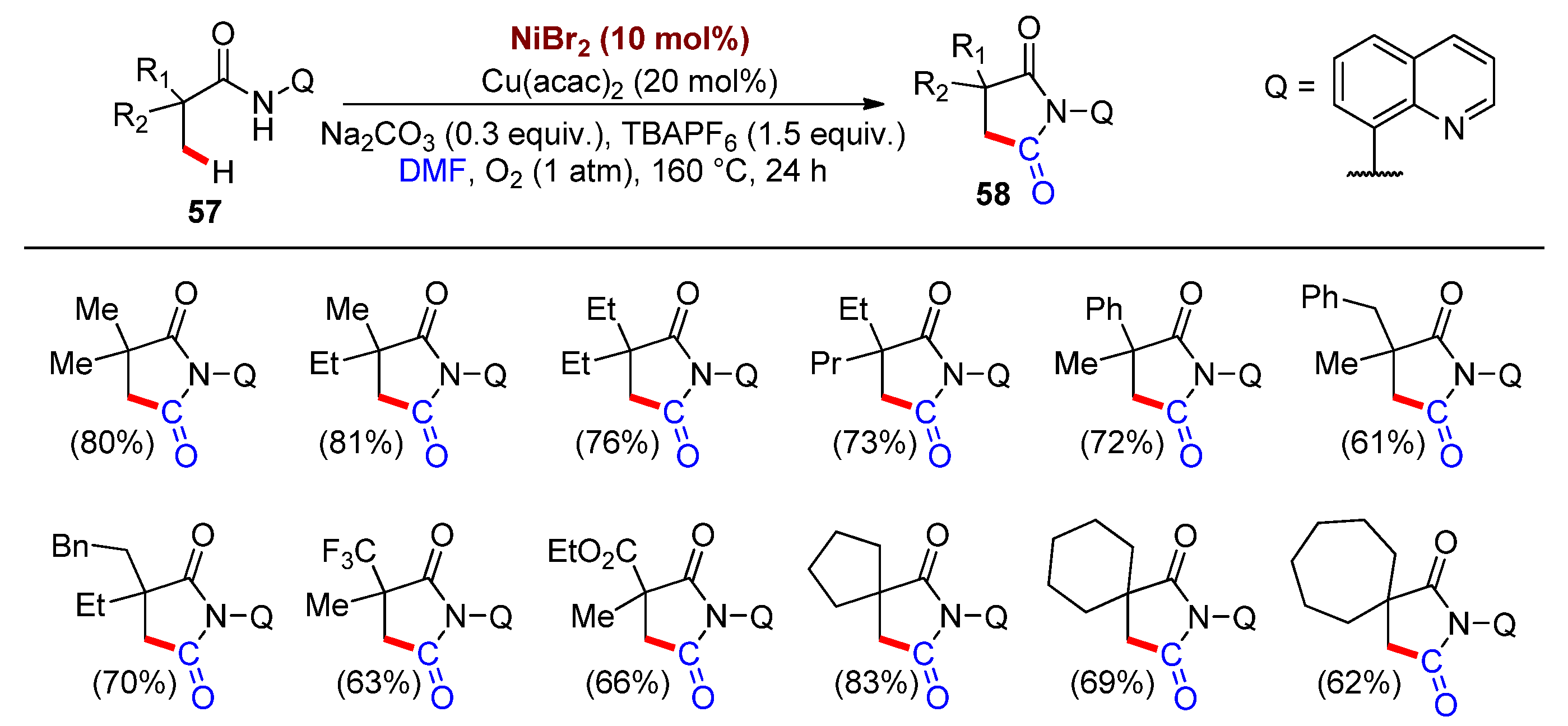
Scheme 5. Synthesis of succinimides 58 by carbonylative cyclization of aliphatic C(sp3)−H bonds of amides 57 using DMF as a CO surrogate, promoted by the synergistic action of NiBr2 as the main catalyst and Cu(acac)2 as co-catalyst, reported in 2015 by Ge and co-workers [29]. For each heterocyclic carbonylated product, yield after column chromatography purification is reported in brackets.
3. Critical Aspects and Perspectives in the Synthesis of Heterocycles by Transition Metal-Catalyzed Carbonylation Reactions Involving DMF as a CO Surrogate
We believe that a more detailed comparative discussion on critical aspects and perspectives in the application of transition metal-catalyzed carbonylation reactions involving DMF as CO surrogate for the synthesis of heterocycles is mandatory at this stage.
In this class of reactions, a crucial role is played by the transition metal catalyst. Most of them were carried out with a palladium(II) species, typically under ligandless conditions, responsible for a kinetically decisive C−H bond activation step from which the catalytic cycle is generated. The use of less expensive nickel(II) species, working through a partially different mechanistic pathway, allowed the extension of the development of cyclocarbonylative protocols to other classes of substrates.
However, the use of a co-catalyst was also crucial, in particular for the involvement of DMF as the carbonyl source in the final heterocyclic products. In the protocols developed by Wu and co-workers [28][30] carried out in the absence of a metal co-catalyst, the C=O functional group of DMF was the effective source of CO incorporated in the corresponding cyclocarbonylated products; in these cases, the authors hypothesized a thermal- and acid-mediated decomposition of DMF to give CO, which then entered into the catalytic cycle. In the protocols developed by Das et al. [31] and Ge and co-workers [29] performed in the presence of, respectively, a silver and a copper species as co-catalyst, the methyl group of DMF was actually the source of the carbon atom in the carbonyl group of cyclocarbonylated products; the synergystic action of co-catalyst and atmospheric O2 allowed the decomposition of DMF into an iminium species, which then participated to the mechanistic pathway.
As already pointed out in several points of the manuscript, one of the main drawbacks for most of these protocols is the use of homogeneous metal species, often in high metal loading (>10 mol%), thus contaminating the final products, which often required long and expensive purification procedures in order to remove metal traces (especially in compounds for agrochemical and medicinal applications). In order to address this issue, a more appealing alternative could be the use of transition metal catalysts supported on solid matrices, which has been investigated to date only in the case of Wu and co-workers (using commercial Pd/C) [30]. In fact, these catalytic systems (often used with low metal loading) can be easily recovered by simply filtration and then recycled several times, thus reducing the total cost of the process and enabling it to be scaled up to an industrial level. Moreover, their use avoids metal contamination of the desired products, although hot filtration tests and metal leaching analysis are mandatory in order to rule out the occurrence of metal species into the solution. At the same time, the study of new protocols with lower catalytic loadings should also be performed: in particular, the determination of typical parameters of catalytic activity such as turnover number (TON) and turnover frequency (TOF) could help in the evaluation and comparison of the efficiency and robustness of each catalyst.
Another very important point that in our opinion needs to be further explored is the possibility to apply carbonylative cyclization involving DMF as a CO source to the synthesis of other classes of heterocycles. In this context, we are confident that the use of other metal species as the main catalyst and/or co-catalyst could represent an important opportunity for new advances. It is worth emphasizing that, in some cases, heterogeneous catalysis allows the achievement a specific chemo- and regioselectivity, which is different with respect to the corresponding homogeneous processes. Therefore, the study of supported catalysts in this class of reactions would be highly desirable not only because they allow for an easy separation from reaction medium, but also for the development of new advantageous synthetic protocols for the synthesis of different heterocycles, including for potential applications in supramolecular and material chemistry.
References
- Semchyshyn, H.M. Reactive Carbonyl Species In Vivo: Generation and Dual Biological Effects. Sci. World J. 2014, 2014, 417842.
- Li, M.; Zajaczkowski, W.; Velpula, G.; Jänsch, D.; Graf, R.; Marszalek, T.; Parekh, S.H.; Zagranyarski, Y.; Mali, K.; Wagner, M.; et al. Transformation from helical to layered supramolecular organization of asymmetric perylene diimides via multiple intermolecular hydrogen bonding. Chem. Sci. 2020, 11, 4960–4968.
- Hassan Omar, O.; Falcone, M.; Operamolla, A.; Albano, G. Impact of chirality on the aggregation modes of L-phenylalanine- and D-glucose-decorated phenylene–thiophene oligomers. New J. Chem. 2021, 45, 12016–12023.
- Schoenberg, A.; Bartoletti, I.; Heck, R.F. Palladium-catalyzed carboalkoxylation of aryl, benzyl, and vinylic halides. J. Org. Chem. 1974, 39, 3318–3326.
- Wu, X.-F.; Neumann, H.; Beller, M. Palladium-catalyzed carbonylative coupling reactions between Ar–X and carbon nucleophiles. Chem. Soc. Rev. 2011, 40, 4986–5009.
- Peng, J.-B.; Qi, X.; Wu, X.-F. Recent Achievements in Carbonylation Reactions: A Personal Account. Synlett 2017, 28, 175–194.
- Dekleva, T.W.; Forster, D. The rhodium-catalyzed carbonylation of linear primary alcohols. J. Am. Chem. Soc. 1985, 107, 3565–3567.
- Haynes, A.; Maitlis, P.M.; Morris, G.E.; Sunley, G.J.; Adams, H.; Badger, P.W.; Bowers, C.M.; Cook, D.B.; Elliott, P.I.P.; Ghaffar, T.; et al. Promotion of Iridium-Catalyzed Methanol Carbonylation: Mechanistic Studies of the Cativa Process. J. Am. Chem. Soc. 2004, 126, 2847–2861.
- Morimoto, T.; Kakiuchi, K. Evolution of Carbonylation Catalysis: No Need for Carbon Monoxide. Angew. Chem. Int. Ed. 2004, 43, 5580–5588.
- Wu, L.; Liu, Q.; Jackstell, R.; Beller, M. Carbonylations of Alkenes with CO Surrogates. Angew. Chem. Int. Ed. 2014, 53, 6310–6320.
- Gautam, P.; Bhanage, B.M. Recent advances in the transition metal catalyzed carbonylation of alkynes, arenes and aryl halides using CO surrogates. Catal. Sci. Technol. 2015, 5, 4663–4702.
- Chen, J.; Natte, K.; Spannenberg, A.; Neumann, H.; Beller, M.; Wu, X.-F. Palladium-Catalyzed Carbonylative Annulation of N-Aryl-Pyridine-2-Amines with Internal Alkynes by C–H Activation: Facile Synthesis of 2-Quinolinones. Chem. Eur. J. 2014, 20, 14189–14193.
- Cao, J.; Zheng, Z.-J.; Xu, Z.; Xu, L.-W. Transition-metal-catalyzed transfer carbonylation with HCOOH or HCHO as non-gaseous C1 source. Coord. Chem. Rev. 2017, 336, 43–53.
- Li, H.; Neumann, H.; Beller, M.; Wu, X.-F. Aryl Formate as Bifunctional Reagent: Applications in Palladium-Catalyzed Carbonylative Coupling Reactions Using In Situ Generated CO. Angew. Chem. Int. Ed. 2014, 53, 3183–3186.
- Natte, K.; Dumrath, A.; Neumann, H.; Beller, M. Palladium-Catalyzed Carbonylations of Aryl Bromides using Paraformaldehyde: Synthesis of Aldehydes and Esters. Angew. Chem. Int. Ed. 2014, 53, 10090–10094.
- Shil, A.K.; Kumar, S.; Reddy, C.B.; Dadhwal, S.; Thakur, V.; Das, P. Supported Palladium Nanoparticle-Catalyzed Carboxylation of Aryl Halides, Alkenylsilanes, and Organoboronic Acids Employing Oxalic Acid as the C1 Source. Org. Lett. 2015, 17, 5352–5355.
- Lescot, C.; Nielsen, D.U.; Makarov, I.S.; Lindhardt, A.T.; Daasbjerg, K.; Skrydstrup, T. Efficient Fluoride-Catalyzed Conversion of CO2 to CO at Room Temperature. J. Am. Chem. Soc. 2014, 136, 6142–6147.
- Mondal, K.; Halder, P.; Gopalan, G.; Sasikumar, P.; Radhakrishnan, K.V.; Das, P. Chloroform as a CO surrogate: Applications and recent developments. Org. Biomol. Chem. 2019, 17, 5212–5222.
- Albano, G.; Aronica, L.A. Potentiality and Synthesis of O- and N-Heterocycles: Pd-Catalyzed Cyclocarbonylative Sonogashira Coupling as a Valuable Route to Phthalans, Isochromans, and Isoindolines. Eur. J. Org. Chem. 2017, 2017, 7204–7221.
- Aronica, L.A.; Albano, G.; Giannotti, L.; Meucci, E. Synthesis of N-Heteroaromatic Compounds through Cyclocarbonylative Sonogashira Reactions. Eur. J. Org. Chem. 2017, 2017, 955–963.
- Albano, G.; Giuntini, S.; Aronica, L.A. Synthesis of 3-Alkylideneisoindolin-1-ones via Sonogashira Cyclocarbonylative Reactions of 2-Ethynylbenzamides. J. Org. Chem. 2020, 85, 10022–10034.
- Albano, G.; Evangelisti, C.; Aronica, L.A. Palladium Nanoparticles Supported on Smopex-234® as Valuable Catalysts for the Synthesis of Heterocycles. Catalysts 2021, 11, 706.
- Albano, G.; Morelli, M.; Aronica, L.A. Synthesis of Functionalised 3-Isochromanones by Silylcarbocyclisation/Desilylation Reactions. Eur. J. Org. Chem. 2017, 2017, 3473–3480.
- Albano, G.; Morelli, M.; Lissia, M.; Aronica, L.A. Synthesis of Functionalised Indoline and Isoquinoline Derivatives through a Silylcarbocyclisation/Desilylation Sequence. ChemistrySelect 2019, 4, 2505–2511.
- Albano, G.; Aronica, L.A. From Alkynes to Heterocycles through Metal-Promoted Silylformylation and Silylcarbocyclization Reactions. Catalysts 2020, 10, 1012.
- Chen, Z.; Wang, L.-C.; Wu, X.-F. Carbonylative synthesis of heterocycles involving diverse CO surrogates. Chem. Commun. 2020, 56, 6016–6030.
- Ding, S.; Jiao, N. N,N-Dimethylformamide: A Multipurpose Building Block. Angew. Chem. Int. Ed. 2012, 51, 9226–9237.
- Chen, J.; Feng, J.-B.; Natte, K.; Wu, X.-F. Palladium-Catalyzed Carbonylative Cyclization of Arenes by C-H Bond Activation with DMF as the Carbonyl Source. Chem. Eur. J. 2015, 21, 16370–16373.
- Wu, X.; Zhao, Y.; Ge, H. Direct Aerobic Carbonylation of C(sp2)–H and C(sp3)–H Bonds through Ni/Cu Synergistic Catalysis with DMF as the Carbonyl Source. J. Am. Chem. Soc. 2015, 137, 4924–4927.
- Chen, J.; Natte, K.; Wu, X.-F. Pd/C-catalyzed carbonylative C–H activation with DMF as the CO source. Tetrahedron Lett. 2015, 56, 6413–6416.
- Nageswar Rao, D.; Rasheed, S.; Das, P. Palladium/Silver Synergistic Catalysis in Direct Aerobic Carbonylation of C(sp2)−H Bonds Using DMF as a Carbon Source: Synthesis of Pyrido-Fused Quinazolinones and Phenanthridinones. Org. Lett. 2016, 18, 3142–3145.
More
Information
Subjects:
Biochemical Research Methods
Contributor
MDPI registered users' name will be linked to their SciProfiles pages. To register with us, please refer to https://encyclopedia.pub/register
:
View Times:
2.1K
Entry Collection:
Organic Synthesis
Revisions:
2 times
(View History)
Update Date:
21 Dec 2021
Notice
You are not a member of the advisory board for this topic. If you want to update advisory board member profile, please contact office@encyclopedia.pub.
OK
Confirm
Only members of the Encyclopedia advisory board for this topic are allowed to note entries. Would you like to become an advisory board member of the Encyclopedia?
Yes
No
${ textCharacter }/${ maxCharacter }
Submit
Cancel
Back
Comments
${ item }
|
More
No more~
There is no comment~
${ textCharacter }/${ maxCharacter }
Submit
Cancel
${ selectedItem.replyTextCharacter }/${ selectedItem.replyMaxCharacter }
Submit
Cancel
Confirm
Are you sure to Delete?
Yes
No




